Sold Ceramics
Sold Famille Rose wares 1725-1800
Tea, Coffee and Chocolate wares
Page 3
There was great demand for Chinese porcelain in Europe at the end of the 17th century. This led to the production of a variety of shapes and decorations while the competition between private merchants also contributed to a very varied supply. Besides porcelain decorated in underglaze blue, famille verte and Chinese Imari, many other types emerged, decorated with overglaze enamels that were sometimes combined with underglaze blue. The most important development, however, was the use of a pink-red enamel around 1725. Porcelain decorated with this enamel is called famille rose. Within a very short time this type supplanted famille verte and became the popular choice for all kinds of export porcelain. Mixing the rose with white enamel created shades of colour that suggested depth and volume. Famille rose knows a great variety in quality and decorations. The name was invented in the 19th century; before that it was simply called 'enameled'. Rose enamel was first developed in the Imperial workshops in Beijing and applied on enameled copper and bronze objects. Western chemical knowledge introduced by the Jesuits at the court around 1700 probably played a role. Since c.1725 it also was used on porcelain in Jingdezhen. Initially, the colour had a lilac shade but became a proper pink after c.1730. It was applied rather thickly and, unlike the very thin iron-red, can easily be felt on top of the glaze. Rose was applied on all types of export porcelain and there are countless combinations with other enamels.

Sold Ceramics - Sold Famille Rose wares 1725-1800 - Tea, Coffee and Chocolate wares - Page 3
Object 2010736
Teacup and saucer
China
1730-1740
Provenance: Mark Powley, Fine Chinese Art, San Francisco, The United States of America.
Height of teacup 37 mm (1.46 inch), diameter of rim 72 mm (2.83 inch), diameter of footring 31 mm (1.22 inch), weight 30 grams (1.06 ounce (oz.))
Height of saucer 20 mm (0.79 inch), diameter of rim 114 mm (4.49 inch), diameter of footring 67 mm (2.64 inch), weight 56 grams (1.98 ounce (oz.))
Teacup and saucer on footrings, slightly everted rims. Decorated in various famille rose enamels with a peacock near a tiled terrace in a garden landscape with rockwork, a lingzhi, a flowering peony tree and flowering plants. On the rim a diaper-pattern border with four reserves filled with leafy scrolls. The reverse is undecorated. The teacup is decorated en suite.
The peacock is a symbol of dignity and beauty. It wards off evil and dances when it sees a beautiful woman. As peacocks' feathers were used during the Qing dynasty to denote official ranks, the peacock motif might also express a wish for a good position. (Jörg & Van Campen 1997, p.157)
For a dish similarly decorated in various famille rose enamels with peacocks in a garden landscape, please see;
Condition:
Teacup: A tiny frit to the rim.
Saucer: Perfect.
References:
Price: Sold.
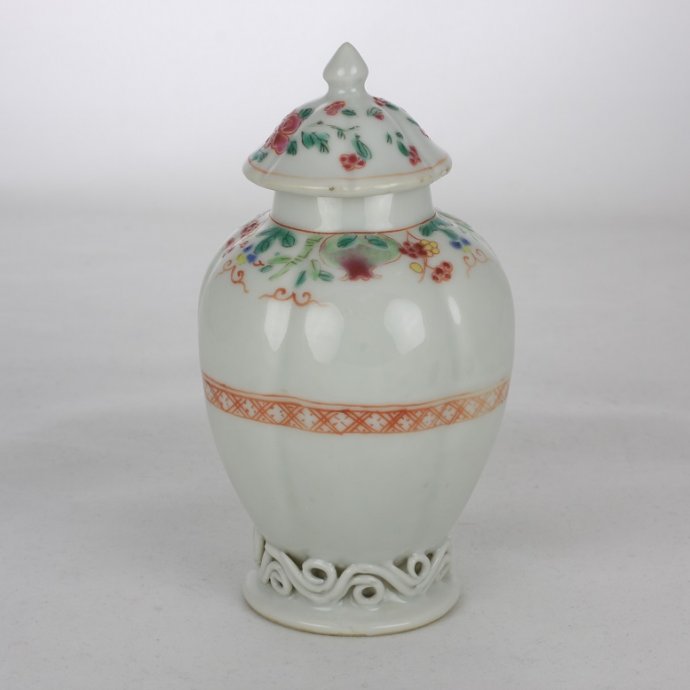
Sold Ceramics - Sold Famille Rose wares 1725-1800 - Tea, Coffee and Chocolate wares - Page 3
Object 2010675
Tea caddy
China
1730-1740
Height including cover 130 mm (5.12 inch), height excluding cover 106 mm (4.17 inch), diameter 73 mm (2.87 inch), diameter mouthrim 29 mm (1.14 inch), diameter of footring 45 mm (1.77 inch), weight with cover 193 grams (6.81 ounce (oz.)), weight cover 32 grams (1.13 ounce (oz.))
Tea caddy of ovoid form on footring, domed cover with a pointed knob. Applied scroll work at the spreading foot. Decorated in various famille rose enamels with iron-red. On the waist a trellis-pattern border and around the neck pomegranates, flowerings branches and leaves. On the cover a flowering chrysanthemum spray.
The term 'famille rose' was first coined by the 19th-century French author Albert Jacquemart, who distinguished between specific groups in his descriptions of Oriental ceramics. (Jörg 2003/2, p.25)
Dimensions:
Condition: A tiny glaze frit and three spots of popped bubbles of glaze on the rim caused during the firing process.
References:
Jacquemart & Le Blant 1862, pp. 77-105
Price: Sold,
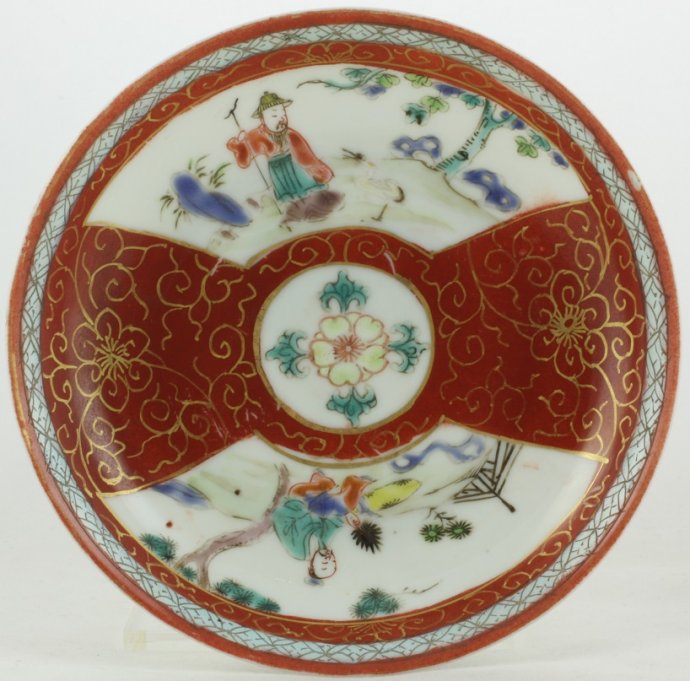
Sold Ceramics - Sold Famille Rose wares 1725-1800 - Tea, Coffee and Chocolate wares - Page 3
Object 2011707
Saucer
China
1725-1735
Height 20 mm (0.79 inch), diameter of rim 115 mm (4.53 inch), diameter of footring 65 mm (2.56 inch), weight 48 grams (1.69 ounce (oz.))
Saucer on footring with a straight slightly flaring rim. The base is glazed. Polychrome decorated in iron-red, black, gold and other overglaze enamels with a central roundel filled with a single flower head surrounded by golden flower heads and scroll work on an iron-red ground and two wide, fan-shaped, panels filled with figures in a landscape. Around the rim a trellis pattern border. The reverse is undecorated.
Condition: Four frits, one to the footring and three to the rim.
Price: Sold.
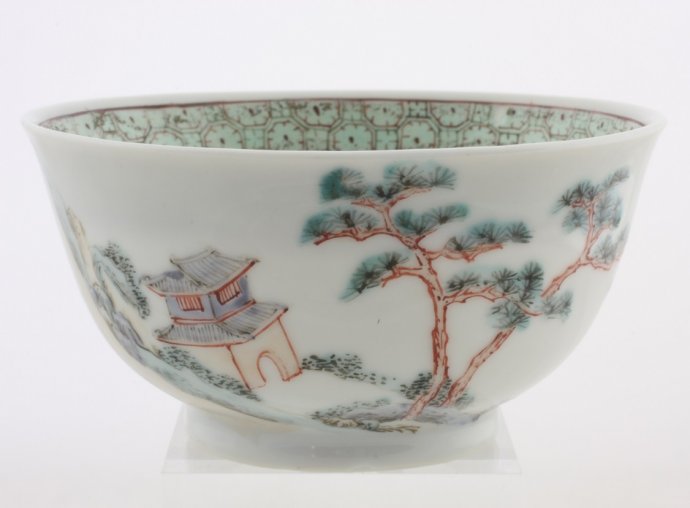
Sold Ceramics - Sold Famille Rose wares 1725-1800 - Tea, Coffee and Chocolate wares - Page 3
Object 2011592
Teacup
China
1730-1735
Height 37 mm (1.45 inch), diameter of rim 72 mm (2.84 inch), diameter of footring 32 mm (1.26 inch), weight 37 grams (1.31 ounce (oz.))
Teacup on footring, straight rim. Decorated in various famille rose enamels, iron-red, overglaze black and other enamels with a continuous landscape scene with mountains, rocks, a pine tree, a pagoda and a figure sitting near a shore. On the bottom a central peony flower spray and round the rim a cell-pattern border. The matching saucer is missing.
Condition: A hairline to the rim and a frit to the footring.
Price: Sold.
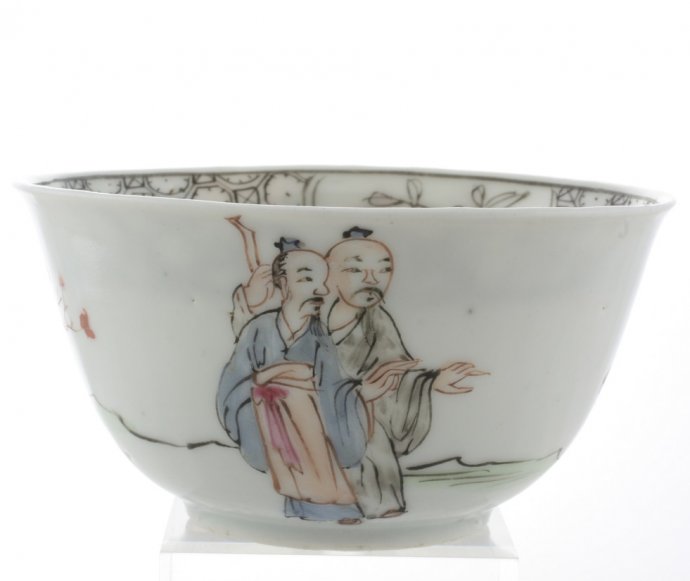
Sold Ceramics - Sold Famille Rose wares 1725-1800 - Tea, Coffee and Chocolate wares - Page 3
Object 2011591
Teacup
China
1730-1735
Height 39 mm (1.54 inch), diameter of rim 74 mm (2.91 inch), diameter of footring 34 mm (1.34 inch), weight 37 grams (1.31 ounce (oz.))
Teacup on footring, slightly everted rim. Decorated in various famille rose enamels, iron-red, black, gold and other overglaze enamels with a continuous scene of two men and a servant carrying a Qin or Gu Qin (a musical string instrument) in a landscape with rocks and flowering branches. On the bottom a decoration of an orchid (cymbidium virescens). Around the inner rim a diaper pattern border with four reserves filled with flowering leafy branches. The matching saucer is missing.
In ancient China, one of the 'ideal' life styles is the leisure gathering with friends with common interests. They could be music, poetry, philosophy or calligraphy. It was highly regarded as being noble and spiritually, beside being enjoyable. Traditionally the design on this teacup has been named 'carrying a Qin to visit a friend' (S.Fan)
The orchid (cymbidium virescens), the Lan Hua. is a motif commonly seen on fine Chinese export porcelain of around 1740.
Condition: A short hairline to the rim.
Price: Sold.
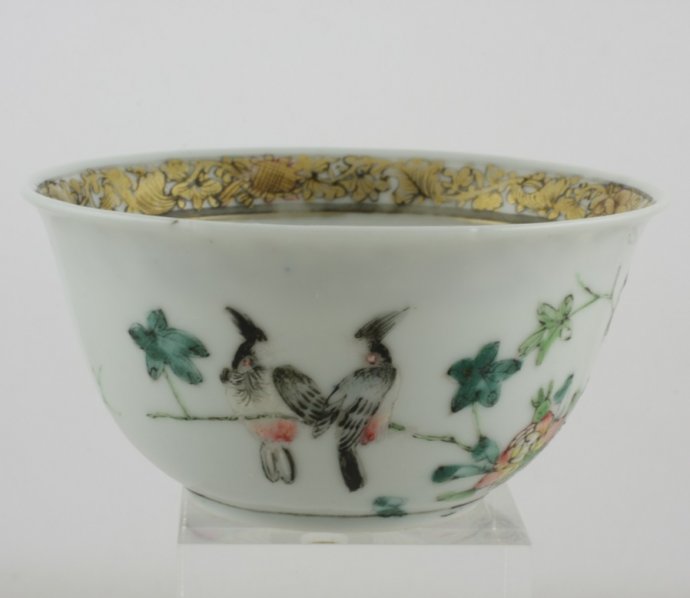
Sold Ceramics - Sold Famille Rose wares 1725-1800 - Tea, Coffee and Chocolate wares - Page 3
Object 2011688
Teacup
China
1730-1735
Height 37 mm (1.54 inch), diameter of rim 75 mm (2.91 inch), diameter of footring 33 mm (1.34 inch), weight 37 grams (1.31 ounce (oz.))
Teacup on footring, slightly everted rim. Decorated in various famille rose enamels, iron-red, black, gold and other overglaze enamels with three birds perched on flowering peony branches. On the bottom a single flower spray. Around the inner rim a foliate and floral scroll pattern border.
Condition: Some wear to the enamels and a frit to the rim.
Price: Sold.

Sold Ceramics - Sold Famille Rose wares 1725-1800 - Tea, Coffee and Chocolate wares - Page 3
Object 2012321
Teacup and saucer
China
1730-1740
Height of teacup 36 mm (1.72 inch), diameter of rim 65 mm (2.56 inch), diameter of footring 28 mm (1.10 inch), weight 28 grams (0.99 ounce (oz.))
Height of saucer 20 mm (0.79 inch), diameter of rim 106 mm (4.17 inch), diameter of footring 60 mm (2.36 inch), weight 45 grams (1.59 ounce (oz.))
Teacup and saucer on footring, spreading sides and everted rim. Decorated in various famille rose enamels with a seated woman watching naughty chicken in a landscape with flowering peony plants growing from taihu (garden) rocks. the saucer is decorated en suite.
Condition:
Teacup: Some enamel loss and fleabites and frits to the rim.
Saucer: Two fleabites to the reverse rim.
References:
Jacquemart & Le Blant 1862, pp. 77-105.
Price: Sold.

Sold Ceramics - Sold Famille Rose wares 1725-1800 - Tea, Coffee and Chocolate wares - Page 3
Object 2011096
Saucer
China
1730-1740
Height 19 mm (0.75 inch), diameter of rim 115 mm (4.53 inch), diameter of footring 66 mm (2.60 inch), weight 53 grams (1.87 ounce (oz.))
Saucer on footring, slightly everted rim. Decorated in various famille rose enamels, iron-red and black with a lady and a little boy in a garden landscape with flowering plants, taihu (garden) rocks and a bird inside a bird cage hanging from a branch of a flowering peony. The lady presents a cup, most likely containing food for the bird, to the little boy. The reverse is undecorated.
The bird cage with a bird was a well-known symbol of chastity and virginity in European art. In the Netherlands, these slender women engaged in some form of activity in a landscape or on a veranda, were called 'lange lijzen', translated in English as Long Eliza's. The term 'famille rose' was first coined by the 19th-century French author Albert Jacquemart, who distinguished between specific groups in his descriptions of Oriental ceramics. (Jörg 2003/2, p.25 & p.96), (Jörg 1989/2, pp.198-199)
Condition: A tiny hairline and a frit to the rim.
References:
Jacquemart & Le Blant 1862, pp.77-105
Price: Sold.
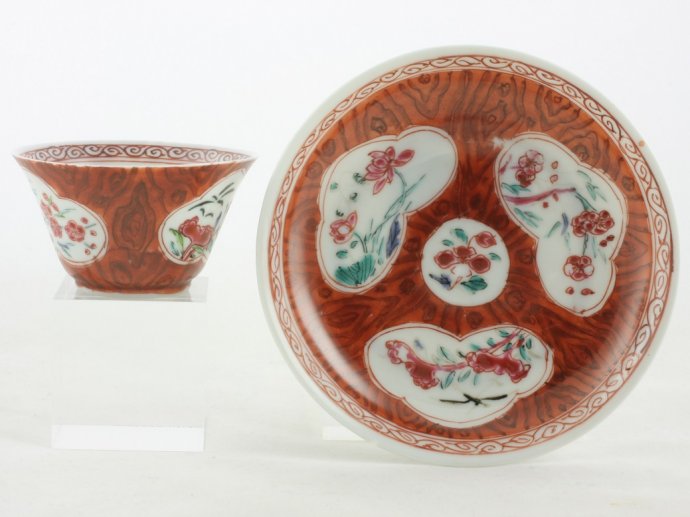
Sold Ceramics - Sold Famille Rose wares 1725-1800 - Tea, Coffee and Chocolate wares - Page 3
Object 2011954
Teacup and saucer
China
1730-1750
Height of teacup 35 mm (1.38 inch), diameter of rim 64 mm (2.52 inch), diameter of footring 27 mm (1.06 inch), weight 23 grams (0.81 ounce (oz.))
Height of saucer 18 mm (0.71 inch), diameter of rim 108 mm (4.25 inch), diameter of footring 63 mm (2.48 inch), weight 38 grams (1.34 ounce (oz.))
Teacup and saucer on footrings, slightly everted rims. Decorated in enamel colours with a central roundel filled with a flower spray surrounded by three medallions filled with flowering plants all on an iron-red-brown ground. Round the rim a scroll pattern border. The reverse is undecorated. The teacup is decorated en suite.
To the Chinese the imitation of one material by another was an artistic challenge. Hence we see objects made of porcelain having the appearance of bronze, bamboo, marble or soapstone (see object 2011827), jade, coral, lacquer and, as in this case, wood. This wood grain decoration is named faux bois and must have appealed to the Western Rococo taste with its similar love of illusion. (Jörg & Van Campen 1997, pp.215-215, cat. 239)
For similarly with 'wood grain' decorated objects, please see:
-
Keramiek uit Azië, (B. Harrisson, Leeuwarden 1985), p. 96, cat. 113.
- Chinese Ceramics in the Collection of the Rijksmuseum Amsterdam. The Ming and Qing Dynasties, (C.J.A. Jörg in collaboration with J. van Campen, Rijksmuseum Amsterdam, London 1997), pp.215-215, cat. 239.
Condition teacup: Some tiny fleabites and a frit with a connected hairline to the rim.
Condition saucer: A frit with a connected hairline to the rim.
References:
Jacquemart & Le Blant 1862, pp. 77-105
Jörg & Van Campen 1997, cat. 239
Price: Sold.

Sold Ceramics - Sold Famille Rose wares 1725-1800 - Tea, Coffee and Chocolate wares - Page 3
Object 2010518
Saucer
Provenance: China
1730-1740
Height 18 mm (0.63 inch), diameter of rim 100 mm (4.10 inch), diameter of footring 60 mm (2.40 inch), weight 45 grams (1.59 ounce (oz.))
Saucer on footring, slightly everted rim. Decorated in various famille rose enamels, with a flowering tree, a flowering peony plant and two birds, one in flight the other perched on a branch of the tree. The reverse is undecorated.
The term 'famille rose' was first coined by the 19th-century French author Albert Jacquemart, who distinguished between specific groups in his descriptions of Oriental ceramics. (Jörg 2003/2, p.25)
Condition: A firing flaw to the exterior wall and a fleabite to the footring.
References:
Jacquemart & Le Blant 1862, pp. 77-105
Price: Sold.
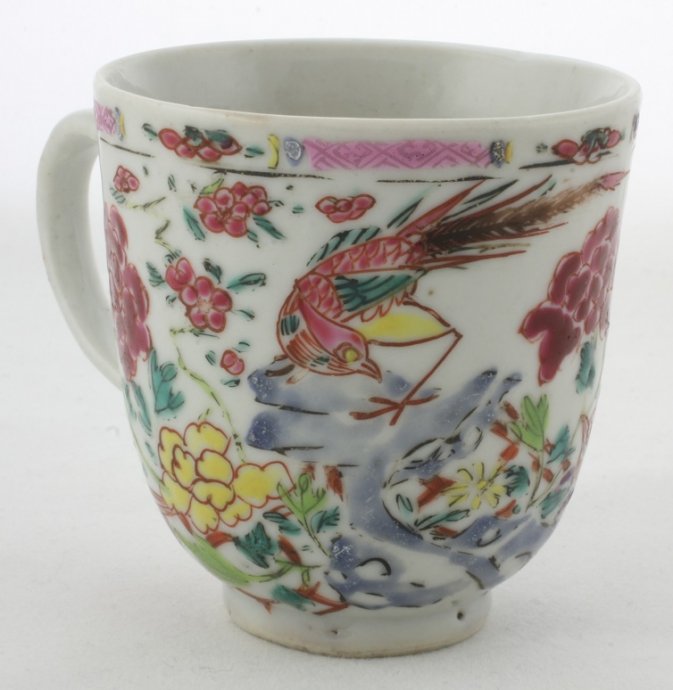
Sold Ceramics - Sold Famille Rose wares 1725-1800 - Tea, Coffee and Chocolate wares - Page 3
Object 2010767
Cup
China
1730-1740
Height 62 mm (2.44 inch), diameter of mouthrim 59 mm (2.32 inch), diameter of footring 28 mm (1.10 inch), weight 73 grams (2.58 ounce (oz.))
Cup with handle on footring. Decorated in various famille rose enamels with ducks, pheasants and a flowering peony growing near a fence behind pierced taihu (garden) rockwork. On the handle a floret between scrolls.
The pheasant on a rock is a very popular motif on export porcelain and frequently appears on enamelled and underglaze blue Kangxi wares. According to Williams, in the Chinese bureaucratic hierarchy officials of the second grade had a gold pheasant embroidered on their court robes, those of the fifth grade a silver pheasant. The bird was represented as standing on a rock, looking towards the sun, the imperial symbol of authority. The term 'famille rose' was first coined by the 19th-century French author Albert Jacquemart, who distinguished between specific groups in his descriptions of Oriental ceramics. (Williams 1976, pp.322-323), (Jörg & Van Campen 1997, p.157), (Jörg 2003/2, p.25)
Condition: Some tiny firing flaws.
References:
Jacquemart & Le Blant 1862, pp. 77-105
Price: Sold.

Sold Ceramics - Sold Famille Rose wares 1725-1800 - Tea, Coffee and Chocolate wares - Page 3
Object 2010332
Saucer
China
1730-1740
Height 17 mm (0.67 inch), diameter of rim 100 mm (3.94 inch), diameter of footring 58 mm (2.28 inch)
Saucer on footring, slightly everted rim with six small indentations. Decorated in various famille rose enamels, iron-red, black, gold and other overglaze enamels with chickens, flags, figures, pagodas and shrubbery before a crenulated wall. The reverse is undecorated. The matching teacup is missing.
The scene of is unusual. This type of decoration, with the brick wall and the pagoda is often referred to as the 'Chinese wall' while others think it is a Chinese fortress within walls.
The indented rim is characteristic of a group of well-enamelled tea-wares of a thin, pure body produced during the Yongzheng and Qianlong reigns. (Jörg & Van Campen 1997, p.213)
Condition: A chip to the rim and outer footring and a X-shaped hairline to the bottom.
Reference:
Jörg & Van Campen 1997, cat. 237
Price: Sold.
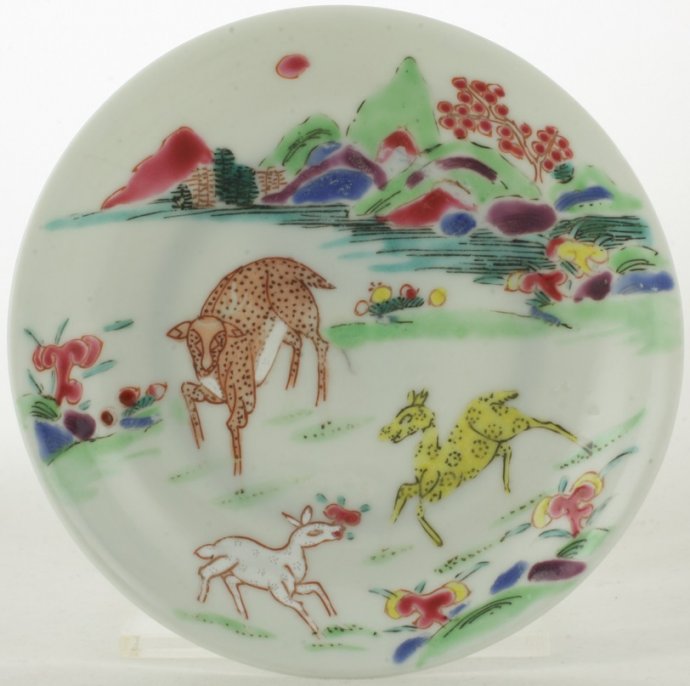
Sold Ceramics - Sold Famille Rose wares 1725-1800 - Tea, Coffee and Chocolate wares - Page 3
Object 2012432
Saucer
China
1730-1740
Height 19 mm (0.74 inch), diameter of rim 103 mm (4.05 inch), diameter of footring 61 mm (2.40 inch), weight 39 grams (1.38 ounce (oz.))
Saucer on footring, slightly everted rim. Decorated in various famille rose enamels with in the centre and the foreground three spotted deer: one pink, one yellow, one white. They are prancing around in a Chinese landscape with many funghi growing on rocks. The white spotted deer is carrying a lingzhi in his mouth. In the background a mountainous landscape. The reverse is undecorated.
Between 1720 and 1730 the Chinese porcelain producers developed a new enamel colour, pink. It derived from colloidal gold. The technique was first used in China in the Imperial workshops in Beijing, for coloured glass and enamels on metal. It became very successful instantly and soon replaced famille verte. The term famille rose was first coined by the 19th-century French author Albert Jacquemart, who distinguished between specific groups in his descriptions of Oriental ceramics. (Jörg & Van Campen 1997)
The spotted deer design symbolises best wishes for a career as an official and good fortune and prosperity. This is because the Chinese word for deer, lu, has the same sound as the word for the high salary of a Chinese official. Another reason for the association with Chinese scholar-bureaucrats or literati is that one of the concluding rituals of the provincial examinations that had to be passed if one was to become an official in the Chinese civil service was a party known as the Banquet of Auspicious Omens, ore more literally the Deer-cry Banquet.
More frequently however, in Daoist mythology the spotted deer are considered auspicious animals connected to immortality. This is because they were believed to attain great age. Furthermore, they were the only animals able to locate and eat the special fungus of longevity, lingzhi. These special mushrooms were found on the paradise islands of Penglai. In Chinese mythology the Penglai mountain is often called the base of the Eight Immortals, or at least where they travelled to have a banquet. In Chinese art the spotted deer usually accompanies Shoulao or Magu, the God and Goddess of Longevity. Because of all this, even today the horns of deer have an important place in Chinese medicine and can be found in every Chinese apothecary shop. The soft internal part of the horns is dried, pulverised, and made up into pills. The inferior parts are boiled up into jelly or tincture.
The importance of spotted deer in Chinese culture today was also reflected in a gift by Taiwan to the Chinese mainland in 2011 of two rare sika or spotted deer for the Liugongdao National Forest Park in east China's Shandong Province. (GOV.cn Chinese Government's Official Web Portal). The sika deer is one of the very few deer species that does not lose its spots upon reaching maturity. Spot patterns vary with the region. The color of the pelage ranges from mahogany to black, and white individuals are also known.(source: wikipedia.org)
According to Bjaaland Welch, in Chinese legends the different colours of the deer signified the age: a 1000-year-old deer was depicted with grey fur, a white one, as can be seen on this saucer, stood for an impressive age of 5000 years.
Condition: A frit with a connected hairline to the rim and a restored hole in the centre.
References:
Jacquemart & Le Blant 1862, pp.77-105
Jörg & van Campen 1997, pp.205-207
Bartholomew 2006, p.102/164, also cat.5.7, 6.7, 6.7.5,7.16
Bjaaland Welch 2008, pp.116-118
Price: Sold.
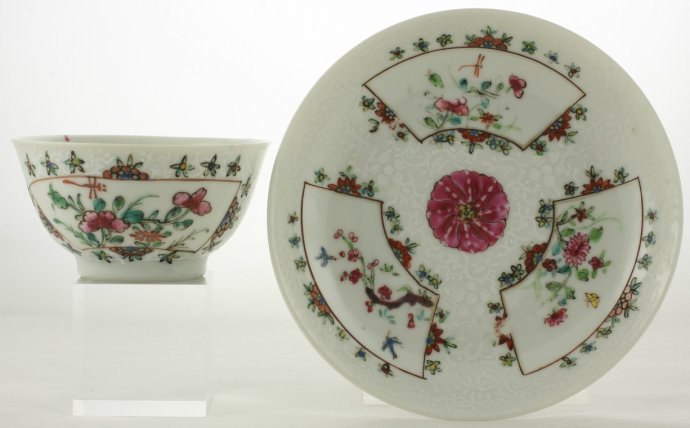
Sold Ceramics - Sold Famille Rose wares 1725-1800 - Tea, Coffee and Chocolate wares - Page 3
Object 2011042A
Teacup and saucer
China
1735-1745
Height of teacup 41 mm (1.61 inch), diameter of rim 80 mm (3.15 inch), diameter of footring 38 mm (1.50 inch)
Height of saucer 22 mm (0.87 inch), diameter of rim 122 mm (4.80 inch), diameter of footring 71 mm (2.80 inch)
Teacup and saucer on footrings, slightly everted rims. Decorated in various famille rose enamels, iron-red, black, gold, white overglaze enamel (bianco sopra bianco) and other overglaze enamels with a central single lotus flower head (symbol for summer) with leaves, on the sides and rim three, fan-shaped, panels, the first filled with a flowering peony (symbol for spring) and an insect. The second with a flowering chrysanthemum (symbol for autumn) and a butterfly in flight and the third with a flowering prunus (symbol for winter) with two birds in flight. The space around the central lotus flower head with leaves and the three panels is filled with a white enamelled bianco sopra bianco flower pattern. The reverse of the saucer is undecorated. Th teacup is decorated en suite.
J. Kroes states in: Chinese Armorial Porcelain for the Dutch market, (J. Kroes, The Hague 2007), that "bianco sopra bianco", (Italian: "white on white"), is a decorative technique of white enamel over white or undecorated glazed porcelain, usually to create a lace-like effect. It was common around 1740-1750. The bianco sopra bianco decoration technique replaced a background in which flowers and scrollwork were incised under the glaze. (Jörg 1995, pp.75-76), (Kroes 2007, p.653)
Condition:
Teacup: A frit and a hairline to the rim.
Saucer: Perfect.
References:
Price: Sold.
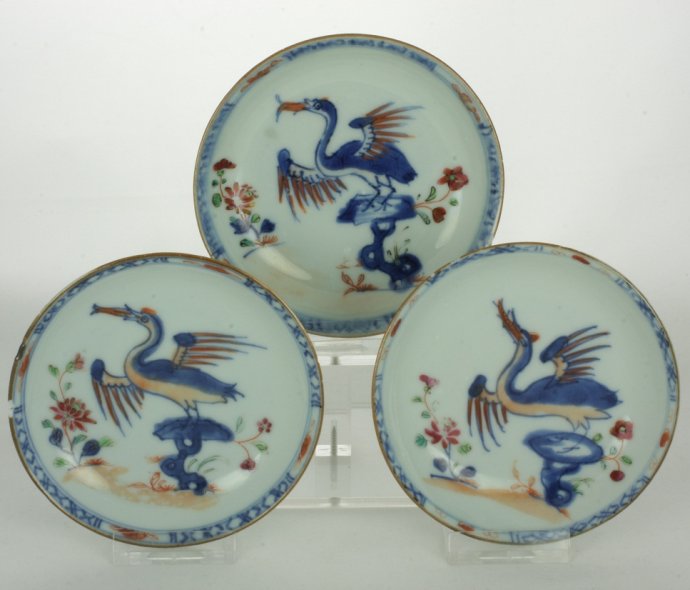
Sold Ceramics - Sold Famille Rose wares 1725-1800 - Tea, Coffee and Chocolate wares - Page 3
Objects 2010538, 2010539 and 2010540
Three saucers
China
1740-1750
Height 20 mm (0.79 inch), diameter of rim 105 mm (4.13 inch), diameter of footring 60 mm (2.36 inch)
Three saucers on footrings, straight underglaze brown-edged rims (jia mangkou). Decorated in underglaze blue, various famille rose enamels, iron-red, black and other overglaze enamels with a Heron standing on a taihu (garden) rock with a fish in its beak. On the rim a trellis pattern border with four reserves filled with a single flower head. The reverses is undecorated. The matching teacups are missing.
For an identically decorated teacup and saucer, please see:
- Have a Cup of Tea. Chinese Porcelain and Tea in North-West Germany, (Exhibition catalogue, Isensee Verlag, Oldenburg, 2015), p.91, cat. 61 / Made in China, Porzellan und Teekultur im Nordwesten, (Exhibition catalogue, Isensee Verlag, Oldenburg, 2015), p.125, cat. 61.
Condition:
2010538: A chip and four hairlines to the rim.
2010539: A chip, some tiny fritts/fleabites, a hairline and a firing flaw all to the rim.
2010540: A chip, a few fleabites and a firing flaw with a small connected glaze hairline.
References:
Price: Sold.

Sold Ceramics - Sold Famille Rose wares 1725-1800 - Tea, Coffee and Chocolate wares - Page 3
Object 2011252
Teacup and saucer
China
1740-1760
Height of teacup 41 mm (1.61 inch), diameter of rim 76 mm (2.99 inch), diameter of footring 37 mm (1.46 inch)
Height of saucer 22 mm (0.87 inch), diameter of rim 120 mm (4.72 inch), diameter of footring 73 mm (2.87 inch)
Teacup and saucer on footrings, slightly everted rims. Decorated in various famille rose enamels, iron-red, black, gold and other overglaze enamels, with two very finely painted ladies and a child in a garden landscape. The teacup is decorated en suite.
On the bottom of the teacup a decoration of an orchid (cymbidium virescens), the Lan Hua. a motif commonly seen on fine Chinese export porcelain of around 1740.
Condition:
Teacup: Two popped bubbles of glaze caused during the firing process.
Saucer: Popped bubbles of glaze caused during the firing process, a fleabite and a frit with a short connected hairline to the rim.
Price: Sold.
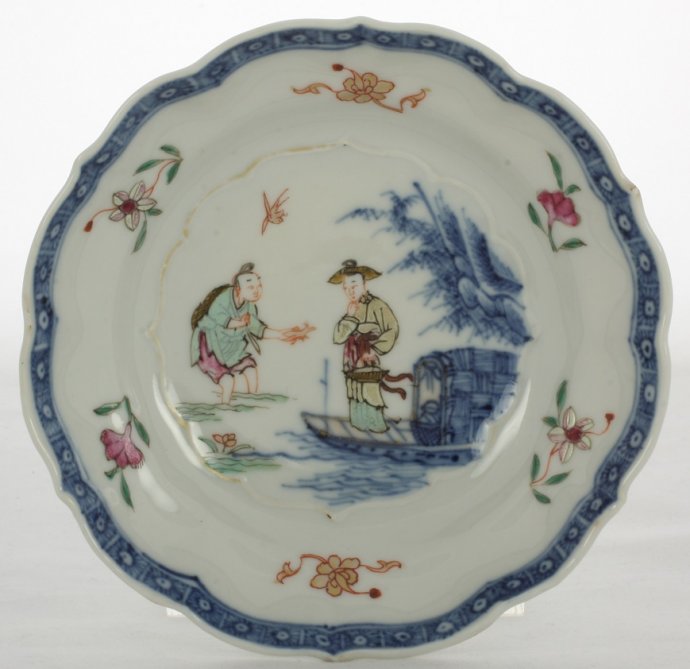
Sold Ceramics - Sold Famille Rose wares 1725-1800 - Tea, Coffee and Chocolate wares - Page 3
Object 2010459
Saucer
China
1740-1760
Height 32 mm (1.26 inch), diameter of rim 117 mm (4.61 inch), diameter of footring 64 mm (2.52 inch)
Saucer on footring, fluted sides with a foliated rim. Decorated in underglaze blue, various famille rose enamels, iron-red, black and other overglaze enamels with a fisherman handing a fish to a lady standing on a boat holding a basket. On the sides six sprays of various flowering branches and around the rim a narrow honeycomb motif border. The reverse is undecorated. The matching teacup is missing.
Condition: Three tiny glaze fleabites to the rim and a X-shaped glaze hairline to the base that is not visible in the front.
Price: Sold.

Sold Ceramics - Sold Famille Rose wares 1725-1800 - Tea, Coffee and Chocolate wares - Page 3
Object 2010257
Saucer
China
1770-1780
Height 28 mm (1.10 inch), diameter of rim 139 mm (5.47 inch), diameter of footring 85 mm (3.35 inch)
Saucer on footring, straight rim. Polychrome decorated in various overglaze enamels, iron-red and gold with a central group of flowers surrounde by five large and five small cartouches each filled with flowering branches. The reverse is undecorated.
Condition: A hairline to the rim..
Price: Sold.


 create websites
create websites